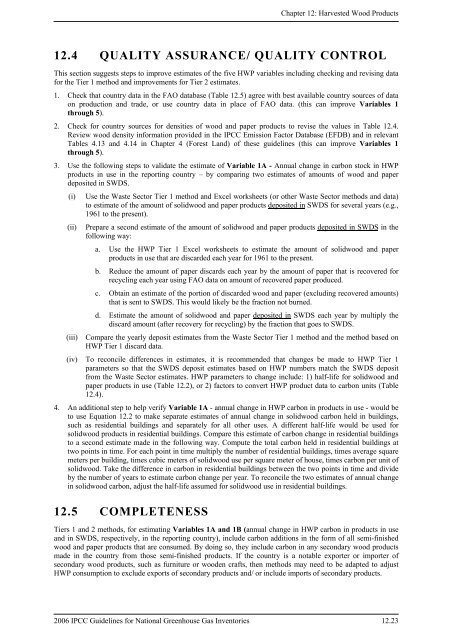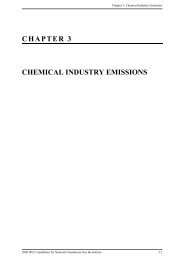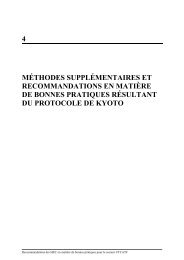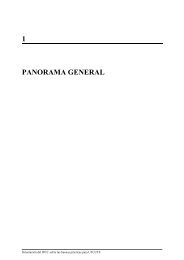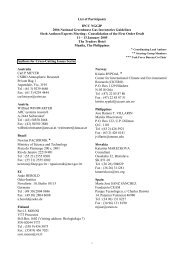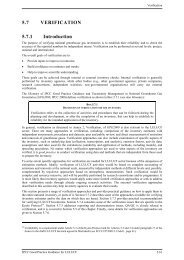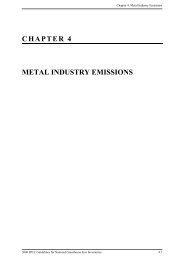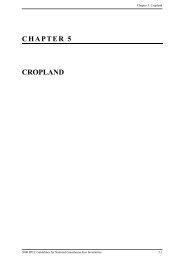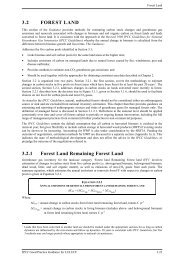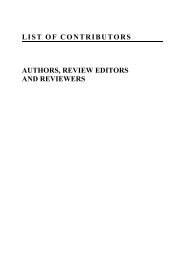chapter 12 harvested wood products - IPCC - Task Force on ...
chapter 12 harvested wood products - IPCC - Task Force on ...
chapter 12 harvested wood products - IPCC - Task Force on ...
Create successful ePaper yourself
Turn your PDF publications into a flip-book with our unique Google optimized e-Paper software.
Chapter <str<strong>on</strong>g>12</str<strong>on</strong>g>: Harvested Wood Products<br />
<str<strong>on</strong>g>12</str<strong>on</strong>g>.4 QUALITY ASSURANCE/ QUALITY CONTROL<br />
This secti<strong>on</strong> suggests steps to improve estimates of the five HWP variables including checking and revising data<br />
for the Tier 1 method and improvements for Tier 2 estimates.<br />
1. Check that country data in the FAO database (Table <str<strong>on</strong>g>12</str<strong>on</strong>g>.5) agree with best available country sources of data<br />
<strong>on</strong> producti<strong>on</strong> and trade, or use country data in place of FAO data. (this can improve Variables 1<br />
through 5).<br />
2. Check for country sources for densities of <str<strong>on</strong>g>wood</str<strong>on</strong>g> and paper <str<strong>on</strong>g>products</str<strong>on</strong>g> to revise the values in Table <str<strong>on</strong>g>12</str<strong>on</strong>g>.4.<br />
Review <str<strong>on</strong>g>wood</str<strong>on</strong>g> density informati<strong>on</strong> provided in the <str<strong>on</strong>g>IPCC</str<strong>on</strong>g> Emissi<strong>on</strong> Factor Database (EFDB) and in relevant<br />
Tables 4.13 and 4.14 in Chapter 4 (Forest Land) of these guidelines (this can improve Variables 1<br />
through 5).<br />
3. Use the following steps to validate the estimate of Variable 1A - Annual change in carb<strong>on</strong> stock in HWP<br />
<str<strong>on</strong>g>products</str<strong>on</strong>g> in use in the reporting country – by comparing two estimates of amounts of <str<strong>on</strong>g>wood</str<strong>on</strong>g> and paper<br />
deposited in SWDS.<br />
(i)<br />
(ii)<br />
Use the Waste Sector Tier 1 method and Excel worksheets (or other Waste Sector methods and data)<br />
to estimate of the amount of solid<str<strong>on</strong>g>wood</str<strong>on</strong>g> and paper <str<strong>on</strong>g>products</str<strong>on</strong>g> deposited in SWDS for several years (e.g.,<br />
1961 to the present).<br />
Prepare a sec<strong>on</strong>d estimate of the amount of solid<str<strong>on</strong>g>wood</str<strong>on</strong>g> and paper <str<strong>on</strong>g>products</str<strong>on</strong>g> deposited in SWDS in the<br />
following way:<br />
a. Use the HWP Tier 1 Excel worksheets to estimate the amount of solid<str<strong>on</strong>g>wood</str<strong>on</strong>g> and paper<br />
<str<strong>on</strong>g>products</str<strong>on</strong>g> in use that are discarded each year for 1961 to the present.<br />
b. Reduce the amount of paper discards each year by the amount of paper that is recovered for<br />
recycling each year using FAO data <strong>on</strong> amount of recovered paper produced.<br />
c. Obtain an estimate of the porti<strong>on</strong> of discarded <str<strong>on</strong>g>wood</str<strong>on</strong>g> and paper (excluding recovered amounts)<br />
that is sent to SWDS. This would likely be the fracti<strong>on</strong> not burned.<br />
d. Estimate the amount of solid<str<strong>on</strong>g>wood</str<strong>on</strong>g> and paper deposited in SWDS each year by multiply the<br />
discard amount (after recovery for recycling) by the fracti<strong>on</strong> that goes to SWDS.<br />
(iii) Compare the yearly deposit estimates from the Waste Sector Tier 1 method and the method based <strong>on</strong><br />
HWP Tier 1 discard data.<br />
(iv) To rec<strong>on</strong>cile differences in estimates, it is recommended that changes be made to HWP Tier 1<br />
parameters so that the SWDS deposit estimates based <strong>on</strong> HWP numbers match the SWDS deposit<br />
from the Waste Sector estimates. HWP parameters to change include: 1) half-life for solid<str<strong>on</strong>g>wood</str<strong>on</strong>g> and<br />
paper <str<strong>on</strong>g>products</str<strong>on</strong>g> in use (Table <str<strong>on</strong>g>12</str<strong>on</strong>g>.2), or 2) factors to c<strong>on</strong>vert HWP product data to carb<strong>on</strong> units (Table<br />
<str<strong>on</strong>g>12</str<strong>on</strong>g>.4).<br />
4. An additi<strong>on</strong>al step to help verify Variable 1A - annual change in HWP carb<strong>on</strong> in <str<strong>on</strong>g>products</str<strong>on</strong>g> in use - would be<br />
to use Equati<strong>on</strong> <str<strong>on</strong>g>12</str<strong>on</strong>g>.2 to make separate estimates of annual change in solid<str<strong>on</strong>g>wood</str<strong>on</strong>g> carb<strong>on</strong> held in buildings,<br />
such as residential buildings and separately for all other uses. A different half-life would be used for<br />
solid<str<strong>on</strong>g>wood</str<strong>on</strong>g> <str<strong>on</strong>g>products</str<strong>on</strong>g> in residential buildings. Compare this estimate of carb<strong>on</strong> change in residential buildings<br />
to a sec<strong>on</strong>d estimate made in the following way. Compute the total carb<strong>on</strong> held in residential buildings at<br />
two points in time. For each point in time multiply the number of residential buildings, times average square<br />
meters per building, times cubic meters of solid<str<strong>on</strong>g>wood</str<strong>on</strong>g> use per square meter of house, times carb<strong>on</strong> per unit of<br />
solid<str<strong>on</strong>g>wood</str<strong>on</strong>g>. Take the difference in carb<strong>on</strong> in residential buildings between the two points in time and divide<br />
by the number of years to estimate carb<strong>on</strong> change per year. To rec<strong>on</strong>cile the two estimates of annual change<br />
in solid<str<strong>on</strong>g>wood</str<strong>on</strong>g> carb<strong>on</strong>, adjust the half-life assumed for solid<str<strong>on</strong>g>wood</str<strong>on</strong>g> use in residential buildings.<br />
<str<strong>on</strong>g>12</str<strong>on</strong>g>.5 COMPLETENESS<br />
Tiers 1 and 2 methods, for estimating Variables 1A and 1B (annual change in HWP carb<strong>on</strong> in <str<strong>on</strong>g>products</str<strong>on</strong>g> in use<br />
and in SWDS, respectively, in the reporting country), include carb<strong>on</strong> additi<strong>on</strong>s in the form of all semi-finished<br />
<str<strong>on</strong>g>wood</str<strong>on</strong>g> and paper <str<strong>on</strong>g>products</str<strong>on</strong>g> that are c<strong>on</strong>sumed. By doing so, they include carb<strong>on</strong> in any sec<strong>on</strong>dary <str<strong>on</strong>g>wood</str<strong>on</strong>g> <str<strong>on</strong>g>products</str<strong>on</strong>g><br />
made in the country from those semi-finished <str<strong>on</strong>g>products</str<strong>on</strong>g>. If the country is a notable exporter or importer of<br />
sec<strong>on</strong>dary <str<strong>on</strong>g>wood</str<strong>on</strong>g> <str<strong>on</strong>g>products</str<strong>on</strong>g>, such as furniture or <str<strong>on</strong>g>wood</str<strong>on</strong>g>en crafts, then methods may need to be adapted to adjust<br />
HWP c<strong>on</strong>sumpti<strong>on</strong> to exclude exports of sec<strong>on</strong>dary <str<strong>on</strong>g>products</str<strong>on</strong>g> and/ or include imports of sec<strong>on</strong>dary <str<strong>on</strong>g>products</str<strong>on</strong>g>.<br />
2006 <str<strong>on</strong>g>IPCC</str<strong>on</strong>g> Guidelines for Nati<strong>on</strong>al Greenhouse Gas Inventories <str<strong>on</strong>g>12</str<strong>on</strong>g>.23


